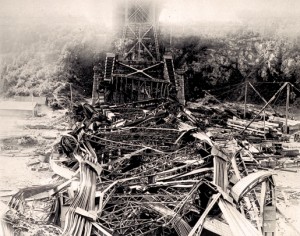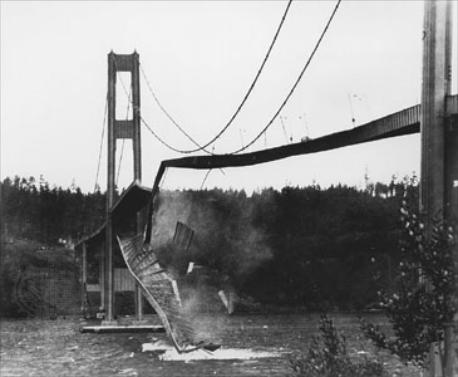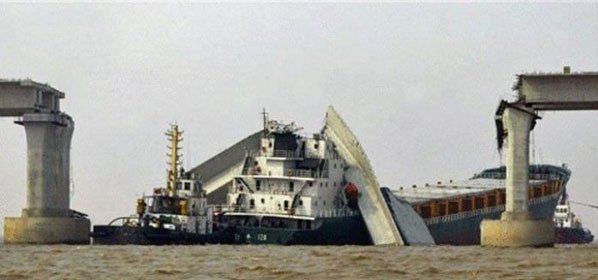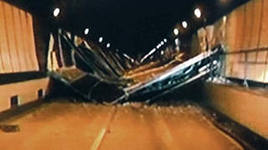
- •Росжелдор
- •Unit 1 railway and motorway engineering structures
- •First, scan the text and then read it more carefully
- •1.2 Give the equivalents in Russian of the following terms
- •1.3 What are the English equivalents of the following Russian terms?
- •1.4 Complete and translate the following sentences using the word list
- •1.5 Translate into English the following sentences
- •1.6 Match the English and Russian terms
- •1.7 Answer the following questions
- •1.8 Render the text according to your plan and give the names of most famous railway and motorway engineering structures in Russia and abroad Unit 2 bridge crossing and its components
- •2.1 Read the following text and make a plan for it
- •Superstructure (пролётное строение); 2 – Pier (опора); 3 – Abutment (устой);
- •2.2 Give the Russian equivalents of the following terms
- •2.3 Give the English equivalents of the following terms
- •2.4 Complete and translate the following sentences
- •2.5 Translate into English the following sentences
- •2.6 Match the words in column a with column b
- •2.7 Read the questions and see if you can answer them
- •2.8 Render the text according to your plan Unit 3 bridge classification
- •3.1 Read the text and make up a bridgework glossary in Russian
- •3.2 Find the Russian equivalents for the following English terms
- •3.3 Find the English equivalents to the following Russian terms
- •3.4 Complete and translate the following sentences
- •3.5 Translate into English the following sentences
- •3.6 Answer the questions
- •3.7 Describe different bridge structures according to their structural design using the terminology below
- •Unit 4 bridges of moscow
- •4.1 Read the text to have a basic notion of bridges in the capital of Russia.
- •4.2 Find the Russian equivalents for the following English terms
- •4.3 Find the English equivalents to the following Russian terms:
- •4.4 Match English and Russian bridge terminology:
- •4.5 Complete and translate the sentences using the following terms
- •4.6 Translate into English the following sentences
- •4.7 Answer the following questions
- •4.8 Render the text according to your plan Unit 5 bridges of st petersburg
- •5.1 Have you ever been to St Petersburg? If so, try to complement the text with your own information. If not, try to enhance your professional range of knowledge
- •5.10 Translate the text into English
- •Unit 6 timber and masonry bridges
- •6.1 Read the text about different building materials. Compare them and say which one is more suitable for permanent or temporary structures
- •6.6 Complete and translate the following sentences
- •6.7 Translate the following sentences into English
- •6.8 Give a reason to support what you say answering to these questions
- •6.9 Express your ideas about the building qualities of stone and wood Unit 7 reinforced concrete bridges
- •7.1 Read the text and learn the terminology using the list of words
- •7.2 Find the Russian equivalents for the following English terms
- •7.3 Find the English equivalents to the following Russian terms
- •7.4 Make up the questions to the following answers
- •7.5 Complete and translate the following sentences using the Word list
- •7.6 Translate the following sentences into English
- •7.7 Discuss the following questions
- •Unit 8 metal bridges
- •8.1 Think of different building materials and answer the following questions
- •8.2 Read the text and check your answers. How much did you guess correctly?
- •8.3 Find the Russian equivalents for the following English terms
- •8.4 What are the English equivalents for the following Russian terms?
- •8.5 Say whether these statements are true
- •8.6 Match the Russian and English terms
- •8.7 Complete and translate the following sentences
- •8.8 Translate the following sentences into English
- •Unit 9 bridges of great britain
- •9.1 Read the text and improve your knowledge of foreign experiences in bridge building
- •9.2 Tell the story of the Old London Bridge using the following terms
- •9.3 Read the text about famous London bridges and tell about them
- •9.4 Find the Russian equivalents for the following English terms
- •9.5 Read the text about the most astonishing British bridges and tell about them
- •9.6 Find the Russian equivalents for the following English terms
- •9.7 Complete and translate the following text
- •9.8 Complete the following sentences using your own ideas
- •9.9 Answer the following questions
- •9.10 Translate the text into English
- •10.1 After reading the text, prove the idea that suspension structures are the safest among bridgeworks
- •10.2 Find the Russian equivalents for the following English terms
- •10.3 Make up examples with the terms describing a suspension structure
- •10.4 Choose which statements are true
- •10.5 Complete and translate the following sentences
- •10.6 Translate the following sentences into English
- •10.7 Answer the following questions
- •10.8 Describe the Golden Gate Bridge using the following information
- •10.9 Consult this list of bridge terminology while doing the exercises
- •Unit 11 bridges of novosibirsk
- •11.1 Having read the text, complete the information with details you may notice in the pictures
- •11.2 Find the Russian equivalents for the following English terms
- •11.3 Find the Russian equivalents for the following English terms
- •11.4 Match the English and Russian terms
- •11.5 Translate the following sentences into English
- •11.6 Answer the following questions
- •11.7 What bridge across the Ob River do you prefer and why? Express your opinion using the following word combinations
- •11.8 Describe your “dream bridge”. Do you have any ideas that will surprise your classmates? Think of a place for “your” bridge. Unit 12 bridge or tunnel?
- •12.1 Read the text and give your reasons for making a choice between a bridge and a tunnel
- •12.2 Find the Russian equivalents for the following English terms
- •12.3 Find the Russian equivalents for the following English terms
- •12.4 Complete and translate the following sentences using the word list
- •12.5 Translate the following sentences into English
- •12.6 Think over the problems and give your reasons for the right solution
- •12.7 Read this interview and make up your own dialogue using the following expressions
- •Unit 13 construction of supports and foundations
- •13.1 Read the text to get a clear idea of building materials and construction technologies for piers and foundations. Go down the word list and take note of professional terminology.
- •13.2 Find the Russian equivalents for the following English terms
- •13.3 Find the Russian equivalents for the following English terms
- •13.4 Translate the following information into Russian, consulting the terminology list and using the word combinations given below
- •13.5 Translate the following information into English using the terminology list
- •13.6 Give your reasons to support the answers to these questions
- •Unit 14 superstructure construction
- •14.1 Read the text and pay attention to the differences in the various techniques of superstructure construction
- •14.2 Find the Russian equivalents for the following English terms
- •14.3 Find the Russian equivalents for the following English terms
- •14.4 Complete and translate the following sentences using the terminology from previous text and the word list (14.6)
- •14.5 Translate the following sentences into English
- •14.6 Find the relevant information in the texts to answer these questions
- •14.7 Describe superstructure construction methods using the following word combinations
- •Unit 15 construction of suspension and cable-stayed bridges
- •15.1 Read the text and pay attention to the peculiarities of suspension superstructure construction
- •15.2 Find the Russian equivalents for the following English terms
- •15.3 Find the Russian equivalents for the following English terms
- •15.4 Complete and translate the sentences using the following words
- •15.5 Translate the following sentences into English
- •15.6 Find the relevant information in the texts to answer these questions
- •15.7 Describe superstructure construction methods. Remember the following word combinations
- •Unit 16 bridge maintenance
- •16.1 Read the text and make a list of the main ideas you should remember as a future bridge builder
- •16.2 Find the Russian equivalents for the following English terms:
- •16.3 Find the English equivalents for the following Russian terms
- •16.4 Match the equivalents
- •16.5 Complete the following sentences
- •16.6 Read the text and find the equivalents for the following terms
- •16.7 Translate the following sentences into English using terminology from this unit
- •16.8 Find the answers to these questions in the text
- •16.9 Role-play. “On-site review and visual inspection of the bridge components”
- •Unit 17 tunnel classification
- •17.1 Read the text and make a list of tunneling terminology
- •17.2 Find the Russian equivalents for the following English terms
- •17.3 Find the English equivalents for the following Russian terms
- •17.4 Complete and translate the following sentences using the Word list.
- •8 Side Wall Drift (боковая штросса); 9 – Lining (обделка тоннеля);
- •– Tunnel Foot (подошва тоннеля)
- •17.5 Translate the following sentences into English using terminology from the texts. Tell a partner what you found most interesting
- •17.5 Answer the questions using the information from the text and your own ideas
- •17.6 Describe any tunnel using the information model from the following.
- •Unit 18 construction methods of tunnels
- •18.1 Read the text and define recent trends in unneling
- •18.2 Find the Russian equivalents for the following English terms
- •18.3 Find the English equivalents for the following Russian terms
- •18.4 Complete the following sentences using the word list and translate them
- •18.5 Translate the following sentences into English using terminology from previous texts
- •18.6 Make up the answers to these questions. Use the Word list
- •18.7 Read the dialogue below and retell it with a partner
- •18.8 Disagree with each statement
- •Unit 19 shield tunnelling
- •19.1 Read the text to have an idea of state-of-the-art tbm’s
- •Figure 19. 7 Technological Process by the Slurry Shield Complex
- •19.2 Find the Russian equivalents for the following English terms
- •19.3 Find the English equivalents for each of the Russian terms
- •19.4 Complete and translate the following sentences using the list of word combinations below
- •19.5 Complete the following sentences using your own ideas and the Word list below.
- •19.6 Translate the sentences into English
- •19.7 Answer the following questions
- •Unit 20 general idea of the metro
- •20.1 Read the text and find out peculiarities in the underground railway systems of different countries
- •20.2 Find the Russian equivalents for the following English terms
- •20.3 Find the English equivalents for each of the Russian terms from the text
- •20.4 Complete and translate the sentences using the following words and word combinations
- •20.6 Think of the answers and give a reason to support what you say
- •20.7 Complete the following sentences in a suitable way
- •20.8 Discuss the ideas expressed by these two engineers suggesting their solution of public transport development in modern cities
- •Unit 21 the novosibirsk metro
- •21.1 Read the text and complement it with more details from the history and present-day operation of the Novosibirsk Metro
- •21.2 Find the Russian equivalents for the following English terms
- •21.3 Find the English equivalents for each of the Russian terms
- •21.4 Complete the sentences using the following words and render this text in English
- •21.5 Complete and translate the following sentences
- •21.6 Discuss the following questions
- •21.7 Read the dialogue and compose your own conversation with a partner. Use the words and expressions from the model
- •21.8 Try to guess the meaning of the following word combination
- •21.10 Ask each other questions to test your knowledge of the unit Unit 22 structures in the underground
- •22.1 Read the text consulting the Word list for better understanding
- •22.2 Find the Russian equivalents for the following English terms
- •22.3 Find the English equivalents for each of the Russian terms from the text
- •22.4 Translate the sentences using the necessary English equivalents.
- •22.5 Translate the sentences into English paing attention to relevant terminology
- •22.6 Choose which statement is true
- •22.7 Discuss the following questions
- •Unit 23 tunnel maintenance
- •23.1 Having read the text try to prove the idea that tunnel maintenance is much more expensive compared to bridge maintenance. Give your reasons
- •23.2 Find the Russian equivalents for the following English terms
- •23.3 Find the English equivalents for each of the Russian terms
- •23.4 Complete the sentences using the following words
- •23.5 Complete and translate the following sentences
- •23.6 Answer the questions
- •Unit 24 сollapse of bridges and tunnels
- •24.1 Read the text, try to guess the meaning of the words you do not know, and then analyze how many meanings you can guess correctly or nearly correctly
- •24.2 Find the Russian equivalents for the following English terms
- •24.3 Find the English equivalents for each of the Russian terms
- •24.4 Complete the sentences using the following words and translate them into Russian
- •24.5 Translate the sentences into English paying attention to relevant terminology
- •24.6 Working in pairs, practice the questions below and support your opinion by using vivid examples. Make up your own questions
- •Unit 25
- •25.1 Read the text and try to complement its content with detailed information and interesting facts
- •25.2 Find the Russian equivalents for the following English terms and word combinations
- •25.3 Find the English equivalents for each of the Russian terms from the text
- •25.4 Complete the sentences using the following words and translate them into Russian
- •25.5 Complete and translate the following sentences
- •25.6 Answer the following questions
24.5 Translate the sentences into English paying attention to relevant terminology
1. «Нет ничего более поучительного (instructive) для молодых инженеров, чем отчеты об авариях больших сооружений и о средствах (ways), использованных для исправления (repair) повреждений. Добросовестное изложение (honest description) этих происшествий и способов, которыми исправляли их последствия (effect), имеет бóльшую ценность (importance), чем описание самых успешных работ», сказал английский инженер Роберт Стефенсон, строивший железнодорожные мосты, среди которых 400-метровый мост через Менейский пролив.
2. Потеря устойчивости (loss of stability) металлической конструкции, либо её отдельных элементов является одной из основных причин крушений мостов. Английский инженер и учёный Джеймс Э.Гордон сказал: «Нужно было пройти долгий путь, полный сомнений (uncertainty) и катастроф (вроде случая с мостом через реку Тэй), чтобы инженеры убедились [receive evidence (that)] в пользе расчетов». Мостовые аварии и катастрофы привели к развитию научной и инженерной мысли (conviction).
3. Однопутный (single-track) железнодорожный мост длиной 3622,5 м через реку Тэй в Великобритании обрушился в 1879 году. Ветер, дувший со скоростью (velocity) 140 км/ч, обрушил судоходные пролеты (over shipping channel) в воду вместе с проходившим по мосту поездом. Конструкция моста не выдержала давления ветра, так как 20-кратный запас прочности (20-multiple safety factor) предусмотрел (make provision of) вертикальную нагрузку, но не включал боковое давление ветра. Катастрофа Тэйского моста положила начало совершенствованию (development) расчетов мостов на ветровые нагрузки.
4. Металлический железнодорожный мост через реку Кевду в России обрушился в 1875 году. Балочный мост с открытым верхним поясом длиной 33,5 м не имел верхних поперечных связей (cross bracing). Крушение произошло при проходе по мосту рабочего (trial) поезда. Этот трагический эксперимент, послужил причиной возникновения теории устойчивости (stability theory).
5. Консольный мост в Канадском городе Квебек через реку Св. Лаврентия обрушивался дважды. Первая катастрофа произошла в 1907 г. (fig. 24. 3a). Металлическая конструкция массой в 9000 тонн упала в реку, унеся жизни 75 строителей. Причиной крушения оказались элементы нижнего пояса консольной фермы, которые выгнулись (hog) и потеряли устойчивость вследствие бокового выпучивания (lateral buckling). Ошибка (blunder) в расчете собственного веса моста составила 25% и мост проектировали заново (redesign).
6. Второе крушение Квебекского моста, длина которого составляла 988 м, произошло в 1916 году. При монтаже центрального подвесного пролёта длиной 549 м, ферма соскользнула с концевой опоры (slide off the end support), оборвала (break) подъёмные устройства (lifting device) и рухнула (crash down) вместе с монтажниками, 13 из которых погибли. Последствия катастрофы удалось ликвидировать и в 1919 году мост сдали в эксплуатацию.
|
|
a – The first collapse of the Quebec Bridge in 1907 |
b - The Tacoma Bridge collapse under aerodynamic force |
Figure 24.3 Bridge collapses caused by low structural stability
7. Причиной крушения трёхпролётного висячего моста Такома-Нэрроуз в США в 1940 году стали динамические крутильные колебания (torsional vibrations), вызванные поперечным ветром (cross wind) скоростью 19 м/с (fig.24.4b). В расчёте моста не учли действие аэродинамической нагрузки. При ветре полотно моста раскачивалось, и его прозвали (nickname) «Галопирующая Герти» (Galloping Gertie). В течение часа были оборваны подвески, и образовался сильный прогиб (deflection) балок жесткости. Мост сильно изгибался, и части среднего пролета отрывались и падали. Эту аварию назвали «the Pearl Harbor of engineering». Восстановленный мост был открыт в 1950 г. Разрушение моста продвинуло исследования в области аэродинамики и аэроупругости (aeroelasticity) конструкций и изменило подходы к проектированию большепролетных мостов.
8. 15 мая 1971 года произошла трагедия на реке Самаре в г. Куйбышев. В пролёт автомобильного моста врезался сухогруз (bulk carrier). При столкновении рубка (deckhouse) судна зацепила (catch on) мостовой пролет, и железобетонная конструкция сдвинулась вбок (sideward), потеряла точку опоры (supporting point) и рухнула на злополучное (ill-fated) судно. Проектировщики (planner) не предусмотрели креплений (securing in place) мостовой плиты в боковом направлении. Вследствие этого, сравнительно небольшой удар (impact) столкнул (push) тысячетонный пролёт с места, и он рухнул вниз (fig.24.4a).
|
|
a - Bridge collapse caused by collision |
b - Collapce in the Sasago Tunnel in Japan |
Figure 24.4 Collapses of Railway and Motorway Engineering Structures
9. 18 августа 2012 года произошло обрушение подводного тоннеля (immersed tunnel) в Японии. Тоннель длиной 140 м и диаметром 11 м находится на глубине 30 м и соединяет нефтеперерабатывающее предприятие (refinery) с портом Мидзусима. Внезапно прорвало (break through) трубу и вода хлынула (gush out in a sudden and forceful stream) в тоннель. Создалась реальная угроза затопления района города Курасики. На место аварии немедленно прибыли сотрудники поисковых служб (search crew) и спасатели. Только одному рабочему удалось выбраться (struggle out of) из затопленного тоннеля.
10. В декабре 2012 года произошло крушение в самом длинном автомобильном тоннеле Сосаго в Японии, где погибло 9 человек. Осмотр повреждений установил, что причиной катастрофы стала 100-метровая балка, которая рухнула, вызвав обрушение 150 бетонных плит в центральной части тоннеля. Тоннель был в аварийном состоянии, так как балки крепились (secure) к потолку болтами, которые ни разу не менялись со времени открытия тоннеля в 1977 году. Во время обвала в тоннеле находились пассажирские и грузовые транспортные средства. Возник пожар, который мешал (prevent) спасателям разбирать (remove) завал (debris).
11. Сооружение самого длинного в России Северомуйского железнодорожного тоннеля (15 км), который был сдан в эксплуатацию в 2003 году, продолжалось 26 лет. Строительство сопровождалось авариями, которые останавливали (stop) работы на долгое время. Первая тяжелая авария (grave damage) случилась в 1979 году. Проходчики столкнулись с высоконапорным (high-pressure) плывуном, взломавшим гранитную перемычку (barrier). Вода с песком неслась по тоннелю под давлением 14 атмосфер. На ликвидацию последствий ушло более двух лет.
12. Следующий обвал обводнённой (water-bearing) породы заблокировал участок тоннеля в 1999 году. Проходка Северомуйского тоннеля признана самой сложной в мировом опыте тоннелестроения из-за инженерно-геологических условий. Участки с тектоническими разломами (fault) по всей длине трассы тоннеля (tunnel path) сильно отличались между собой обводнённостью, протяженностью и строением. Они нуждались в разных способах проходки. Все приглашенные иностранные специалисты отказались от личного участия, предоставив (supply) только технику.




